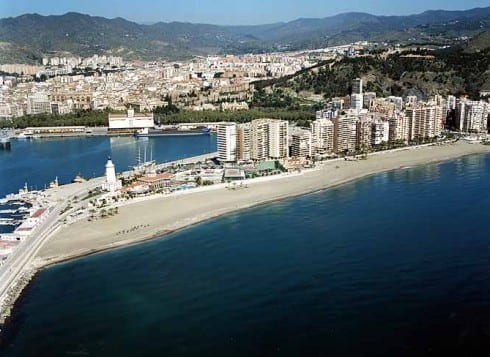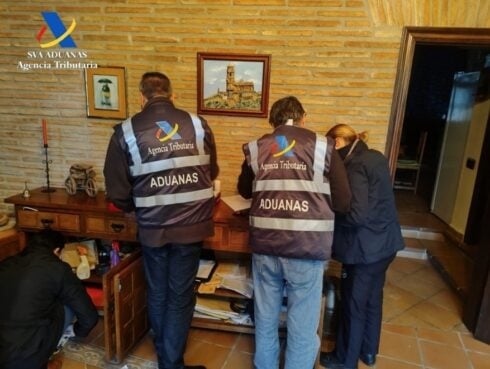Here, in our first exclusive extract from Guardian correspondent Giles Tremlett’s incisive, ground-breaking book Ghosts of Spain, we relive the tragic “secret” events that led to the murder of three innocent, educated women near Avila
SITTING in the late autumn sun, in what had once been the Generalísimo’s plaza, it was not difficult to imagine what had happened here, 66 years earlier. The same crooked, clay-tiled roofs ran down to the wood-balustraded balconies of the buildings around the square. One or two houses were new, and the town hall had been renovated, but the church was, of course, still there. The square was small and unspoilt and on one side looked out over roof-tops and fields.
I had come here to listen to a story that, were Spain not a country whose history is perforated with holes of silence and forgetting, would have been laid gently to rest long ago. It was a story that had erupted out of the past, spilt over into the present and proved one thing – the sores of the Spanish Civil War could still, even now, be reopened. Two-thirds of a century had gone by, but they were still there, untended and only partially cured.
This was my first visit to Poyales del Hoyo, a village of 700 inhabitants. I did not know then that it would be the first of many trips to the fertile valley of the River Tiétar. Apart from the square, its church and lemon trees the pueblo had little special to recommend it. Today was, in any case, a day for the dead, All Saints Day. There was more bustle in the cemetery than in this square, now called the Plaza del Moral. Not so long ago, however, this had been the Plaza del Generalísimo – the superlative title they had given to Europe’s most enduring right-wing dictator, Francisco Franco Bahamonde.
So here, more or less, is what happened on 29 December 1936. The details have undoubtedly been modified over the years, but the core of it, however, is true. It is a tale that could be told in a thousand pueblos. But in most of those places, as they were in Poyales del Hoyo, the shameful events of that period remain secretos a voces – ‘voiced secrets’ that, even today, are only whispered in private.
29 December, 1936
The small lorry was parked in the plaza, between the village hall, the squat, solid church and a covered walkway propped up by irregular granite columns. It was a cold December night. Rain was beating down on Poyales del Hoyo, slipping down the cobbles and mud of the steep, narrow streets and into the fields below.
Perched on the foothills of the Gredos mountains in the central Spanish province of Ávila, Poyales del Hoyo likes to boast that it is protected from the extremes of the weather of the Castilian plain to the south. But the rain, when it comes, can be relentless and puts a dull, matt grey tinge on the white-painted buildings.
The night chosen for killing the three women fell a few days after Christmas and just two before New Year’s Eve. A small crowd had formed as the Falangists prepared to carry out their work. There was no lack of volunteers. Only one man, a future Civil Guard officer called Miguel Suárez, protested at what was about to happen. He pulled a young cousin of his out of the crowd and dragged him out of the square, but he could not stop the rest.
The man in charge was Ángel Vadillo. Later to be known by the nickname Quinientos Uno, literally ‘Five hundred and one,’ he was the leader of the local Falange, the Spanish Phalanx. This party of the extreme right had gathered just 45,000 votes around Spain (and no seat in the Madrid parliament, Las Cortes) in national elections ten months before.
But, as the only party approved by Franco, it was growing rapidly in the areas conquered since the military rebellion against the Republic had erupted in July. Vadillo eventually boasted that he had killed 501 rojos – thus gaining a nickname which, by most accounts, he was proud of.
In the early months, the shootings were a regular occurrence. 501 and his fellow Falangists would meet in the bars of Poyales or, seven miles (eleven kilometres) away, in Celestino’s bar in Candeleda. There they would fortify themselves with vino de pitarra, then, after nightfall, they would go to work.
Tonight it was the turn of Pilar Espinosa, Virtudes de la Puente and Valeriana Granada. The latter, Quinientos Uno’s niece Damiana agrees today, was only there because another woman in the village was jealous of her. Valeriana, aged 26, had once been the woman’s husband’s lover. That was before they had married but, in the cauldron of village life, the jealousy still bubbled away. The woman persuaded her Falange friends to add Valeriana’s name to the list of those due to be killed.
The other two were Republican sympathisers. Pilar was forty-three. She was one of the few in the village who could read. She had subscribed to the newspaper El Socialista. Virtudes, aged fifty-three, was not just a Republican but also a Protestant. She used to bathe, immodestly, in a pool in the river that still bears her name. These were all things that marked her as a potential enemy of Franco’s National Catholic crusade as it swept slowly but inexorably across Spain.
The night has remained crystal clear in the mind of Obdulia, Pilar Espinosa’s daughter. It was the night when she, a 14-year-old girl, accompanied her mother in her last hours of life.
“We were already in bed after a hard day in the fields. Suddenly they were beating at the door. There must have been a dozen of them, dressed up in their blue shirts and leather webbing, armed with rifles and pistols. They told us we had to go and speak to the police, that someone had denounced us,” she recalled.
They were taken to a small warehouse somewhere in the village. But the only questioning they had was from the local priest – who must have known what awaited them.
The Falangists, meanwhile, had gone to get Feliciano Fraile from the police cells. Feliciano was another Republican, but he was also one of the few in Poyales who knew how to drive. He was forced behind the wheel of the small, requisitioned lorry – which the owner, Rufino, had refused to drive. Then the women were brought out and pushed up into the back of the lorry with the men who would kill them.
Back in 1936, the road out of Poyales del Hoyo hugged the contours of the Gredos foothills making gentle S-shapes towards Candeleda. It snaked its way through pastures, olive groves, and orchards of cherry trees or wide-leafed figs. On the right-hand side the Almanzor, ‘The Invincible’ – the highest of the Gredos peaks named after the warrior-like hadjib (prime minister) of the tenth-century Muslim kingdom of Córdoba, Muhammad ibn Abi Amir. On the other side of the road, low hills led south to the scorched plains of Castile, towards Toledo.
On that rainy night, Obdulia and the three women could not see any of this. They were aware of the lurching of the lorry on the curves, the damp seeping in over the tarpaulin and, I am sure, the fearful certainty of their own deaths.
The women could have been shot anywhere along the road. But, evidently, the killers wanted to get away from Poyales del Hoyo. The lorry did stop, once, on the way. Obdulia was ordered out. She had time for a quick embrace with her mother. Then she started back through the rain.
“My mother gave me a hug, and that was the last I saw of her. I ran back through the rain and shut myself into the house. I still don’t know why they let me get off but I don’t feel any gratitude. They killed my mother. I have always hated them for it and I always will,” she recalled.
The chosen spot was on the final curve just before the road straightens out and runs down the hill into Candeleda. The locals knew it as ‘La Vuelta del Esparragal’, ‘the asparagus field curve’. Feliciano, the driver, walked off and left the killers to it. Nobody was worried about him running away. There was nowhere to go. Considerable violence was used on Valeriana, the youngest, who was pregnant. Her skull was smashed. They say that her belly and womb were ripped open with a knife. The other two were shot through the head.
All three bodies were left out in the open beside the road. A peasant discovered them the following morning. He dug a grave, placed the three bodies in a Z-shape, shoveled the earth back and marked the spot with a stone. He died of a heart attack a few days later. People said it was la pena – the pain of his discovery – that killed him.
A new year broke at the end of the following day. It brought with it more war, and many more deaths like those of Pilar, Valeriana and Virtudes. The victims were buried in roadside graves, hurled into pits, gullies and ditches or stuffed down wells. The violence, once unleashed, reached extremes of cruelty on both sides.
The Spanish Civil War, a bloody curtain-raiser for the global war of ideologies that broke out in 1939, did not end for another two and a half years – until April 1, 1939. The country lived under the absolute control of General Franco, Caudillo of Spain, for almost another four decades. Poyales del Hoyo, Candeleda and the rest of the villages strung along the Tiétar Valley lived under the control of those who killed the three women for the same period.
Franco died, still in power, in 1975. The Spanish people, relieved, embraced democracy in record time, consciously fleeing their own brutal past and burying it in silence.
Fear, anyway, has a life of its own. People here kept the secret of the Vuelta del Esparragal for a quarter of a century more.
All Saints’ Day, 2002
Sixty-six years later there is freshly dug earth again at the Vuelta del Esparragal. Mariano is down on his knees in the gash of pale, sandy soil opened up by the mechanical digger. He works his fingers through the drying mud and passes a few small, yellowed shards of human bone and tooth into the palm of one hand. With their primitive, heavy-handed working methods, he explains, the volunteers who came here a few days earlier to disinter the three women had not managed to gather everything.
“Look, this must be one of Valeriana’s teeth. They smashed her skull. We couldn’t find all the bits. We looked for the skeleton of an unborn child, but we could not find all of that either,” he explains.
It is All Saints Day and I have been talking to Mariano for several days. His voice had been getting increasingly excited as the date drew nearer. Sitting in a traffic jam outside Madrid enroute to the village I had called him several times that morning.
These souls have no right to rest
In part two of our moving serialisation of Giles Tremlett’s critically-acclaimed book Ghosts of Spain, we find the PP Conservative mayor of Poyales refusing a decent burial for three innocent female victims of the Civil War
All Saints’ Day, 2002
THE authorities, members of the Conservative right-wing People’s Party, wanted nothing to do with the three sets of bones. Mayoress Damiana González was the niece of Ángel Vadillo, the infamous Quinientos Uno, who was responsible for the killings of Pilar Espinosa, Valeriana Granada and Virtudes de la Puente. She had left town and declined to attend the reburials. She had, grudgingly, left instructions that a reburial should be allowed if it was ‘properly’ requested by relatives. But the town was to do nothing special for these bodies. They were, the mayoress reasoned, just like any others.
Then, two days before the burial, the deputy mayor – a retired Franco-era Civil Guard officer – informed the families that there was no room for the women in the cemetery. In Poyales del Hoyo, a small village of just 700 people, the old splits between left and right were reappearing with vehemence. Here, at least, the accepted wisdom that, 25 years after Franco’s death, Spain had definitively buried the trauma of the Civil War was transparently false.
As the battle of the bodies began, the splits became more apparent. For decades the victims’ families and their killers had lived cheek-by-jowl. The reburials brought an end to the silence which here, as in much of the rest of Spain, had kept the Civil War out of people’s conversations, if not their minds. And, with that, the embers of ancient loathing had begun to glow again.
This was something that, according to the accepted mores of Spain’s transition to democracy, was not supposed to happen. At the beginning of the 21st century, Spain was ruled by the People’s Party. It was the first openly right-wing party to win power through the ballot box since November 1933. ‘Spain is going well,’ was the slogan of the modern and fully democratic right-wing party of José María Aznar. Superficially, at least, Spain fitted the phrase. Material progress was visible in a country flooded with new buildings, new roads and new cars.
The mores of this youthful democracy dictated that the bloody, vicious past had been overcome. Nobody was supposed to meddle with it and for some people then, the digging up of Civil War victims was a kind of treason. It was a breaking of the pact of forgetting – and silence – that had kept the lid tightly screwed down on the past. That silence had been a cornerstone of the swift, dramatic and successful transition to democracy of which Spaniards were, justly, so proud.
What was clear in Poyales, however, was that reconciliation between the victims had been left out of the equation. The families of those on the losing side were, even now, meant to suffer in silence. They were meant to leave their dead scattered in roadside ditches.
Fortunately however the gravedigger in Poyales was a left-winger. The night before the burials, the gravedigger had sworn that, if necessary, he would dig up the patch of ground dedicated to los caídos por Dios y por España, those who fell for God and Spain, or Franco’s Nationalist forces during the Civil War. Mariano liked that idea.
In the end, a small patch of earth was found in the tight, white-washed graveyard. In a ceremony accompanied by poetry and tears, three small, brown caskets were buried side by side. Heliodora, the infant daughter whom Valeriana had handed to a neighbour before climbing into the truck, was there. She was now a woman in her sixties, with neat, short-cut silver hair. She read a simple, self-composed poem, while Pilar’s daugther Obdulia – a squat, olive-faced, healthy-looking 81-year-old – looked on.
We gathered in the square afterwards. There, Ezekiel Lorente, grandson of Virtudes and now a Socialist village councillor, puffed his chest out and held his head high as a local right-winger walked past. “He knows what I am thinking. This is our moment,” he told me.
Stories began to emerge of what life had been like in Poyales del Hoyo under the boot of Ángel Vadillo. A teary-eyed woman appeared with a list of names, hurriedly scribbled down on a piece of scrap paper, of those in the village who were killed. Her own father, Evaristo, was one of them. Another man, ‘El Ratón’ or ‘the mouse’, she claimed, had his eyes gouged out. Soon the piece of paper was being turned over as the list headed past the two dozen.
Obdulia, Pilar’s daughter, who had survived that night, did not set foot in Poyales again for over thirty years. By that time Quinientos Uno was dead, having succumbed to a heart attack while in Arenas de San Pedro. But she remembers seeing another of the killers, El Manolo, “who was very bad,” drinking in the bar. “I wanted to go and say something to him, but my sister wouldn’t let me,” she said. “I didn’t lose my fear until Franco was dead.”
“This thing has stayed in my mind all my life. I’ve never forgotten. I am reliving it now, as we stand here. All the killers were from the village. They came with the intention of killing, and then they went off to confess.”
She is struggling now, to turn that hatred and fear into forgiveness. Finally she fixes me with a watery stare. “I can pardon, but I cannot forget. We have to pardon them or it makes us just like them.”
Two weeks later I returned to talk to the mayor, Damiana Gonzalez. Already in her seventies, she claimed there had been no fuss, no objections and no obstruction to the re-burials. “I have no problem with that,” she said. But she clearly did. As we spoke in her spartan office, she first expressed her shock that the church bells had been rung for ‘non-believers’. “How cynical. None of them would have liked that. They used the church here as a prison,” she said.
Then she launched into a tirade against the Republican committee that had controlled the village in the nine weeks before Franco’s Moorish troops swept into Poyales. The killing of dozens of left-wingers was, she said, merely the result of the left’s own bloodletting. “One lot finished and the next lot got started. They killed one another as much for village arguments and old hatreds as for anything else,” she said.
The three victims in the Candeleda grave, Damiana suggested, were not as innocent as those who dug them up have claimed. “It was said that these women were involved [in the killings], that they pointed people out,” she said. Counselor Lorente’s grandmother Virtudes, the mayoress claimed, had once threatened to kill her own mother with a cobbler’s spike after an argument over a loaf of bread.
Her uncle had, she suggested, turned to violence only after several members of his own family were killed by the left. She was unable, or unwilling, to explain, however, the enthusiasm that her uncle would put into his job as the self-appointed avenger of the Tiétar Valley. His nickname of Quinientos Uno, she suggested, was an exaggeration.
Damiana could not understand the fuss about the graves of Pilar, Virtudes and Valeriana. Educated under Franco, she still believed the propaganda of the time. Had not the Generalísimo built, at the The Valley of the Fallen, outside Madrid, a monument to all the dead of the Civil War, regardless of which side they were on? The common grave of the three women had not been such a big secret. “If they didn’t get them before, it was because they didn’t want to. It was always known that they were there. They should do what has to be done, but not go around saying these things. We would be better off keeping our mouths shut, those on one side and those on the other.”
POSTSCRIPT:
The Civil War was a bloodbath that pitted brother against brother and neighbour against neighbour. By the time the guns had stopped smoking some half a million Spaniards were dead. There are no exact figures, but it is thought that 200,000 were executed by the two sides.
One reason that Spaniards, especially older Spaniards, do not like to talk about the Civil War is that they still disagree so radically on it. Most, even those on the modern right who profess dislike of Franco, blame the bloodletting on one side or the other. Better silence than an argument that might see the blood of one’s grandparents being swapped across the table.
It is a sign of just how much Spain has changed that one of the volunteers involved in digging up graves should be José Antonio Landera – a young member of the same Civil Guard police force that did much of Franco’s dirty work. He told me that his schooling had left him with only vague notions of what had happened in the 1930s. “The Civil War was only talked about superficially. There was no mention of the civilian deaths in virtually every village, of the mass graves or of the disappeared,” he said.
The digging up of graves has had a galvanising effect on what some Spaniards have come to call their own ‘desmemoria histórica.’ This expression was coined to describe an almost deliberate lack of historical memory.
There are still thousands of bodies in unmarked graves. The highest estimates talk of 30,000 unidentified corpses. Around 300 have now been recovered. Since the three women from Poyales were exhumed, two other graves have been identified along the same 11 kilometre stretch of road. They are said to contain 20 corpses of men. The rediscovery of the graves caused the author Isaías Lafuente to pose the question: “Can a democratic country allow thousands of citizens murdered like animals by a dictatorial regime to remain buried in its roadside ditches? Can it tolerate this while the man who allowed and encouraged the mass killings rests under the altar of a Christian basilica? The answer is so obvious that is almost an offence to have to ask the question.”
In the graves of Pilar, Virtudes and Valeriana – and in hundreds more like them – there is proof of a silence that has been both collective and willing. One of Europe’s most verbose and argumentative peoples has simply chosen to look away from a vital part of its history whose ghastly, ghostly presence is to be found under a few feet of soil.
This is an extract from “Ghosts of Spain” by Giles Tremlett (Faber and Faber)
Click here to read more News from The Olive Press.






Well, they have not been allowed to rest long…on Sat the 30th of july, 2011, the newly elected mayor,Antonio Cerro(still the same PP party) has gone down to the cementery and removed the remains of these three victims along with another seven victims from 1936 that were added early this year, put them all in a common unmarked grave and smashed up the tomb. Without consulting the relatives properly.A few days later a peaceful group of people that went along to make a silent protest were met by an enraged group of townsfolk led by the 4 councillors that spat on them, pushed them, insulted them and did everything possible to stop them speaking.